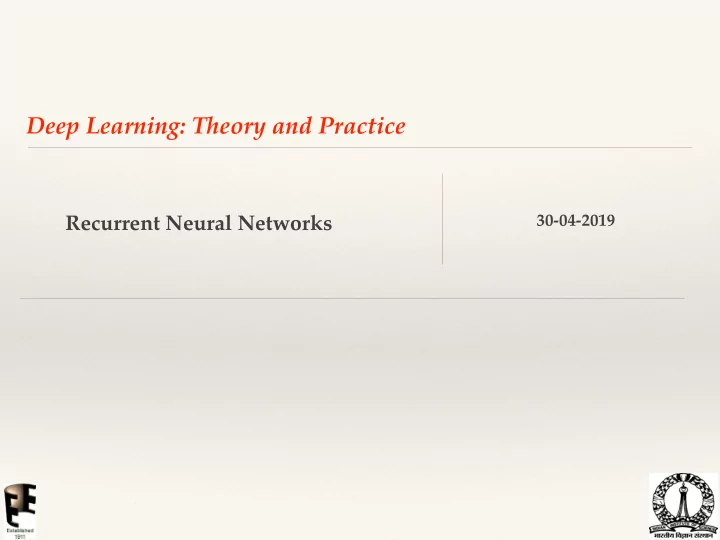

Deep Learning: Theory and Practice 30-04-2019 Recurrent Neural Networks
Introduction ❖ The standard DNN/CNN paradigms ❖ (x,y) - ordered pair of data vectors/images (x) and target (y) ❖ Moving to sequence data ❖ (x(t),y(t)) where this could be sequence to sequence mapping task. ❖ (x(t),y) where this could be a sequence to vector mapping task.
Introduction ❖ Difference between CNNs/DNNs ❖ (x(t),y(t)) where this could be sequence to sequence mapping task. ❖ Input features / output targets are correlated in time. ❖ Unlike standard models where each pair is independent. ❖ Need to model dependencies in the sequence over time.
Introduction to Recurrent Networks “Deep Learning”, Ian Goodfellow, Yoshua Bengio, Aaron Courville
Recurrent Networks “Deep Learning”, Ian Goodfellow, Yoshua Bengio, Aaron Courville
Recurrent Networks “Deep Learning”, Ian Goodfellow, Yoshua Bengio, Aaron Courville
Back Propagation in RNNs Model Parameters Gradient Descent
Recurrent Networks
Back Propagation Through Time
Back Propagation Through Time
Standard Recurrent Networks “Deep Learning”, Ian Goodfellow, Yoshua Bengio, Aaron Courville
Other Recurrent Networks Teacher Forcing Networks “Deep Learning”, Ian Goodfellow, Yoshua Bengio, Aaron Courville
Recurrent Networks Teacher Forcing Networks “Deep Learning”, Ian Goodfellow, Yoshua Bengio, Aaron Courville
Recurrent Networks Multiple Input Single Output
Recurrent Networks Single Input Multiple Output
Recurrent Networks Bi-directional Networks
Recurrent Networks Sequence to Sequence Mapping Networks
Long-term Dependency Issues
Vanishing/Exploding Gradients ❖ Gradients either vanish or explode ❖ Initial frames may not contribute to gradient computations or may contribute too much.
Long-Short Term Memory
LSTM Cell Input Gate f - sigmoid function g, h - tanh function Forget Gate Cell Output Gate LSTM output
Long Short Term Memory Networks
Gated Recurrent Units (GRU)
Attention in LSTM Networks ❖ Attentions allows a mechanism to add relevance ❖ Certain regions of the audio have more importance than the rest for the task at hand.
Encoder - Decoder Networks with Attention
Attention Models
Attention - Speech Example From our lab [part of ICASSP 2019 paper].
Language Recognition Evaluation
End-to-end model using GRUs and Attention
Proposed End-to-End Language Recognition Model
Proposed End-to-End Language Recognition Model
Proposed End-to-End Language Recognition Model
Language Recognition Evaluation State-of-art models use the input sequence directly. We proposed the attention model - Attention weighs th importance of each short-term segment feature for the task. 0-3s : O...One muscle at all, it was terrible Attention Weight 3s-4s : .... ah .... ah .... 4s - 9s : I couldn't scream, I couldn't shout, I couldn't even move my arms up, or my legs 9s -11s : I was trying me hardest, I was really really panicking. Bharat Padi, et al. “End-to-end language recognition using hierarchical gated recurrent networks”, under review 2018.
Language Recognition Evaluation
Language Recognition Evaluation
Recommend
More recommend